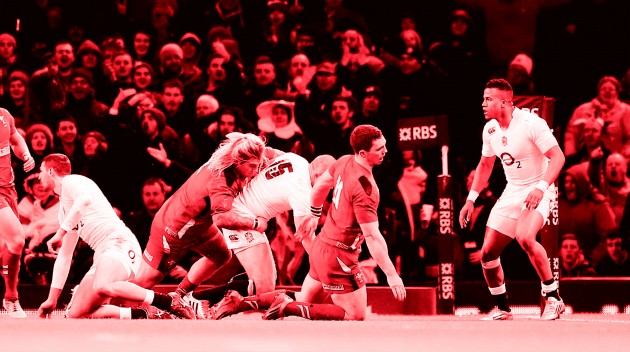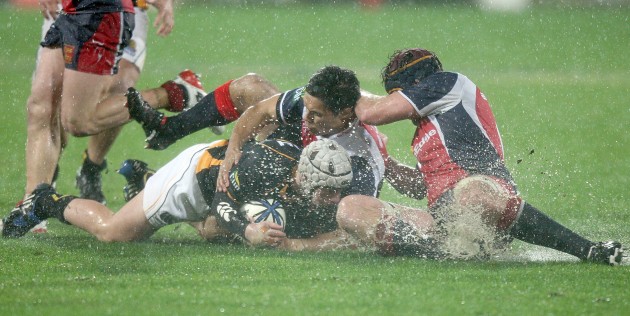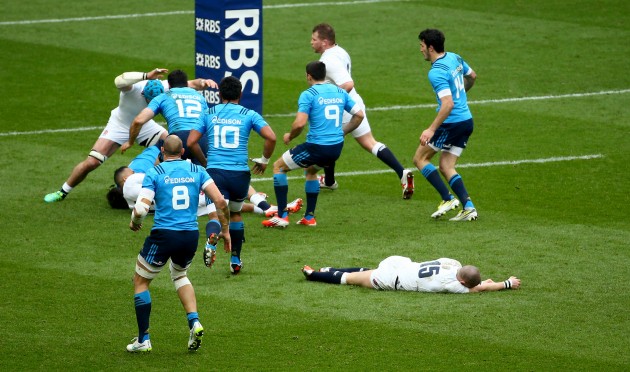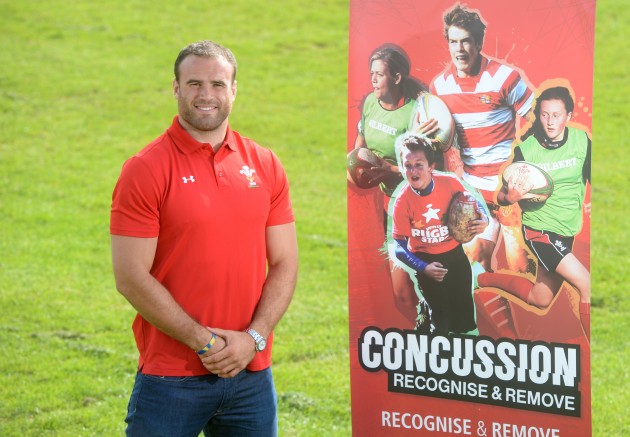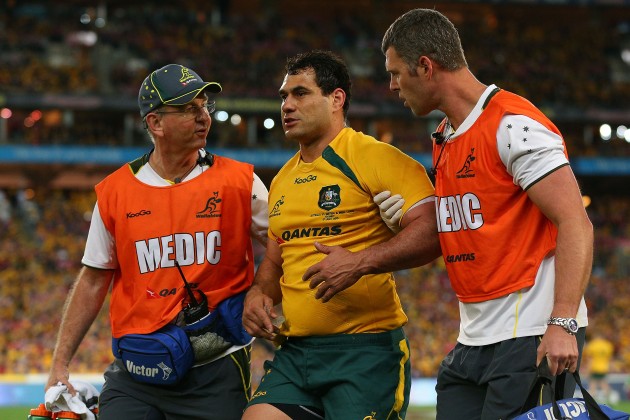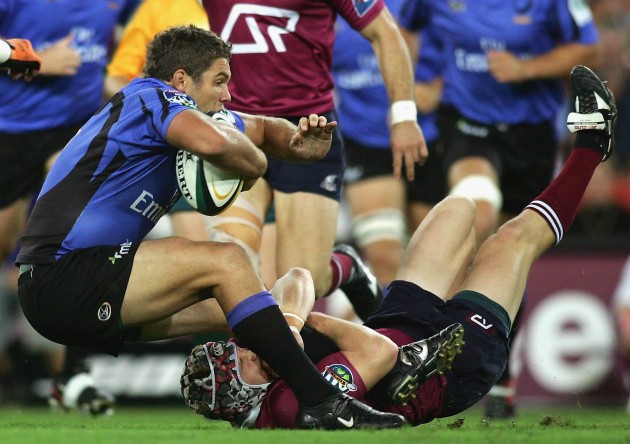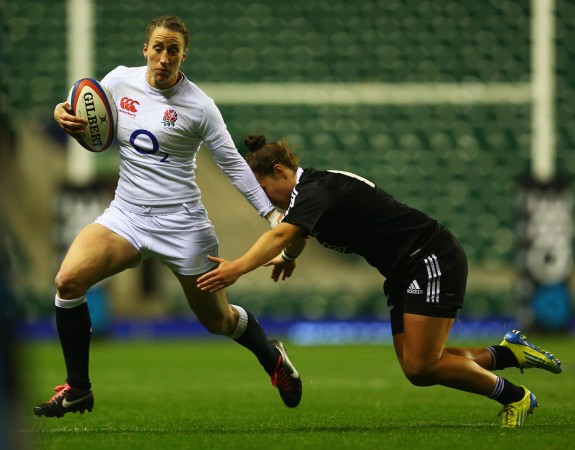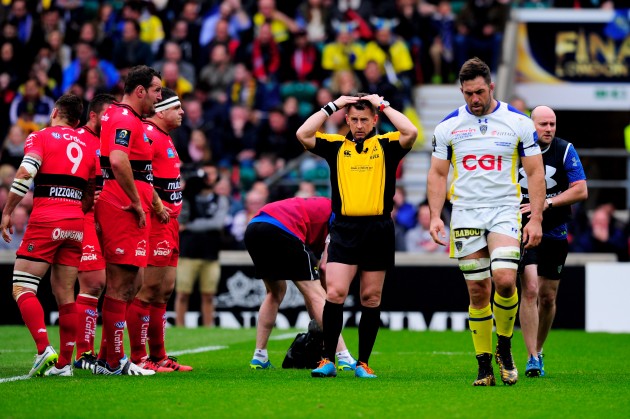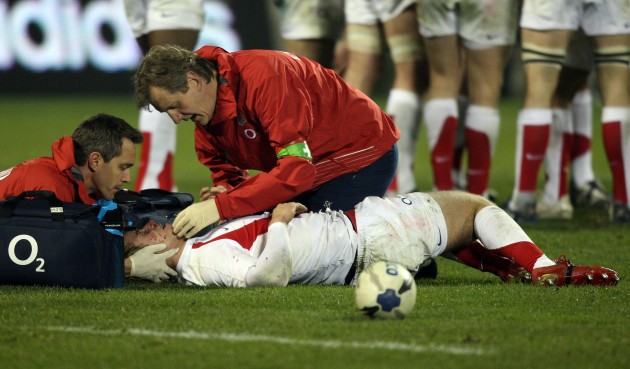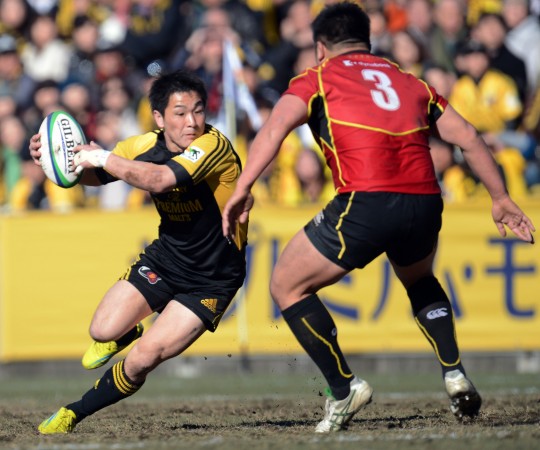In the April issue of Rugby World, we brought you this in-depth report on the biggest problem in rugby.
THE LINE wasn’t great but you could pick up the slight slur in his words. “I’m still trying to get over the last head knock, over two years ago,” Glen Gregory says.
To know of Gregory you’d have to be one of those people who watches any rugby; specifically the ITM Cup in New Zealand. Gregory is a hunting guide now on the north island, but he played in the back row for the Tasman Makos, before chucking his life in a bag and flying over to Siberia for a stint with Krasny Yar Krasnoyarsk in Russian professional rugby. He enjoyed it but it was there where his last concussive blow came.
“It’s mainly headaches I get now,” Gregory says after explaining his long history of concussion. “I’ve learnt to manage my symptoms differently, to cope. I still get really tired and I cannot run, but I manage with a little help (from my parents). I have to wear sunglasses all the time. I get nausea, can’t handle things too loud. I’m looking to get some specialist hearing aids made. But it’s expensive and I get no support in New Zealand. I left that support system behind when I went to Russia; no access to career-ending injury support.”
By his own account Gregory’s style of play was more spit than slick, more dirty groundwork than jinking through holes. He had yarns with Todd Blackadder about drifting towards the Crusaders system but as he fronted up about the state of his head – he was first hospitalised at 16 because of concussion, but got on with it for 11 more years of rugby – he decided that a trip to the vast Russian unknown for a few bucks was a better option for a pro custom-built for rough play.
But at 27, in the build-up to what would potentially be a crowning glory for Krasnoyarsk as they prepared for a cup final, the lights of his career dimmed.
He explains: “In my last ever match I got a boot in the head. I wasn’t KO’d so I played on for 80 minutes. I thought I had gotten away with it. I went to the after-match function, had a few beers… not a great idea.
“I’d had a few concussions before and I had not played a game with all of my symptoms gone. The head coach wanted me sent home (after this last one). I could have gone, but I’d signed a two-year contract. We had to win at all costs. Mate, I was in trouble. The next day, after meeting the president, I had a meeting with the coach and a translator. I couldn’t get up the stairs! But we had a final to play in six weeks from then. I honestly thought I’d come right. I was hiding.”
Hiding is one thing. Lightly ribbing someone for being ‘soft’ is another. But in the cut-throat world of professional rugby outside of the Tier One nations it can be dangerously tough. And cavalier. Gregory tells of local players unable to comprehend head troubles. He also explains that because some of the very same players get paid only if they play, they would purposefully go out in training trying to hurt the man in front of them in the pecking order. Gregory had seen kicks in the head. We often talk of athletes’ livelihoods, but in this case players tear at team-mates to earn their crust. Then you’ve got the ‘medical support’ the player received.
“My speed was sluggish,” Gregory continues. “If I closed my eyes in the shower I’d nearly fall over. The coaches got a doctor to give me a whole heap of drugs. And the symptoms went! I thought, ‘This isn’t good, but I’ll play again!’ I came off the drugs the next day and I felt awful again. They were just masking the symptoms.
“These treatments: you name it, they tried it. They had me hooked up to an IV drip of vitamins. I just had to roll with the punches. And I couldn’t really tell people anything. It really wasn’t easy.
“I couldn’t play the final. It didn’t go down too well. I spoke to the club president and said, ‘Look, I’m done’. I told him I would go away, get right and come back.
“I saw a top specialist in New Zealand, a neurologist and the doctor the Highlanders use. He pretty much said, ‘F***, you’re crazy if you want to play again!’ I honestly thought I’d be told I was going to be alright, but I left there crapping myself. You can come back from a sore knee or something like that, but if you think you’re coming back from this you’re kidding yourself.”
THE GOVERNING MESSAGE
THINGS MAY look grim for Gregory, but he is optimistic, and for all the fears he loved his time in Russia. He would like to coach one day, should his head ever clear enough for him to take it seriously. He was unlucky, sure, but he also takes a lot of the blame. His dad was ‘old school’ when he was 16, some of the Russians lads were ‘old school’ too, but Gregory kept putting himself and his head in harm’s way.
He also believes that the global approach to concussion has changed in the past three years – something World Rugby and several experts in the field would agree with.
World Rugby have sought out the advice of respected specialists like Bob Cantu and Ann McKee to develop concussion guidelines, iron out the Head Injury Assessment (HIA, a series of memory tests and physiological checks used to determine if a player is concussed, within a ten-minute window) and to come up with their laudable ‘Recognise and Remove’ awareness campaign. They insist they worked together to come up with best-practice coaching techniques and commissioned reviews of the laws and norms of play so as to ‘limit exposure to head trauma’. They also suggest the as yet unpublished research into the long-term effects of concussion on players, at Auckland University, could help them further when it is finally completed.
On their message, a World Rugby spokesperson states: “Together we are committed to changing. Rugby operates a zero-tolerance stance towards playing with suspected concussion and the message to the global rugby family is ‘recognise and remove’. Any player with clear concussion symptoms will be removed immediately and must not return.”
Of course, as good as the directives are, it is hard to avoid that feeling that it is two steps forward and one step back with awareness of concussion in Test rugby. And when unavoidable human error does get in the way, it can be potentially dangerous.
Look at the George North incidents against England in this year’s RBS 6 Nations, when, having undergone the HIA and got the all-clear after a first-half kick in the head, he clashed heads with Richard Hibbard. Protocols insist that any suspicion of a lack of consciousness results in automatic removal; no tests, no talks. After the second clash North was as limp as a string of overcooked spaghetti but he stayed on.
Of course, after a review by World Rugby, it became clear this was a case of human error, the medics didn’t see the incident in the thick of the action. However, that showcases an inherent flaw in the system. You dictate a protocol and it’s missed, unknowingly or otherwise – that spells for all sorts of potential disaster.
Dr Willie Stewart, a consultant neuropathologist running studies out of Glasgow University and one of the clearest voices on the issues of concussion in sport, feels that sanctions are the clear way of pushing all Test sides and pro clubs into line. As for our understanding – and here the RFU’s player injuries audit, where the number of reported concussions have increased over the past year by 59%, can be held up – he feels we must embrace that head injuries in rugby are an ever-present worry, not to be accepted then left alone. “What we’re coming around to is a clearer picture of concussions. The number of concussions is being reported better, there are clearer systems. A look at the RFU’s injury audit shows concussions have doubled in the past ten years and are possibly under-reported. The true number could be 50% higher, perhaps? What we need to ask is, at which point is the level of brain injury too high? Perhaps we’ve crossed that line already. I’ll continue to encourage the whole industry to change.
“The NFL, for example, have rectified rules to try to reduce risk and they have been subtle and it’s still the same game. Rugby could do that and it doesn’t need to be outside-of-the-box stuff or part of an expensive study. They spent around £500k on the scrum study at Bath and made some logical changes you and I could have come up with in the pub over a couple of pints. So small changes could come in to rugby that don’t necessarily have to be on a Saturday afternoon. Encourage far less contact in training – save it for the weekend. And cut down on some of the high-risk play. The one (area to be looked at) that comes to mind instantly is the high ball. Making those changes could come in now and while fans might not agree, they would still much rather see players on the park and upright.”
Dr Stewart believes one major barrier to consistent concussion management relates to the many and varied approaches to concussion management in sport, with each sport effectively providing its own, sport-specific guidance. “The only way to progress is for the management to be dictated by the injury, not the sport. To do this requires one single set of common guidelines to be agreed and promoted, at least at grass-roots level.”
There have been high-profile rugby failures that were held up as signs the powers-that-be had to enact change, as with the North incident or the infamous George Smith concussion shocker against the Lions in 2013 or the Florian Fritz debacle last season, when the blood-soaked Toulouse centre left the field with wobbly legs and vacant eyes, but soon re-entered the fray. If you dwell on these incidents at the very top you will be terrified. Yet, you must give credit to those who have done good. Just ask Dr Stewart about the positives.
“Rugby has come so far,” he says. “World Rugby took the step to get Bob Cantu and myself in to look at things, to be very critical. They wanted us to have open, frank discussions about the issue. They’re attempting to make a change. It should evolve and be better researched.”
However, there is another element to this. Why do players, some of whom have recent histories of concussion, want to play on just like Gregory did?
THE PLAYERS’ VIEW
Elton Flatley had the wherewithal to call time on his career at the age of 28. He explains: “In my last game before I retired, I took a knock and had blurred vision in my eye. Over the space of a year I had more issues around concussion and it was frustrating. In that game against the Western Force, I hesitated before taking contact – it was the first time I had ever done that – and I walked off. I said to the doctor, ‘I’m done’.”
He discussed his options with the Queensland Reds team doctor after pulling himself out against the Force. He feared he would let his team-mates down, that by going into contact half-hearted it was all already over. He hung up the boots. But he feels he was blissfully prevented from making calls for himself because his medical support was so hands on, even though this was ten years ago and the fundamental understanding of concussion management was not as advanced as it is now. Yet, he agrees, his symptoms were fairly obvious.
“With concussions, mine was a choice to retire. Some guys may have pushed themselves because they could, whereas my concussions were affecting my performance. I’m a proud guy! If I could still perform maybe I could have been able to play longer, but do I think some competitive athletes mask their problems? Some would say ‘yes’ and we certainly didn’t know as much when I was playing as we do now. We understand long-term consequences better now.”
Yes, but would you have continued if you were playing well and remained fearless, even with the concussions? “I can understand why some athletes would want to continue. It’s a great environment, being a sportsman. The real world is scary. But you’ve only got one melon. I still love this game but you have to look after your head.”
Such self-awareness isn’t confined to the Australian game or even the men’s game. Kat Merchant won the Women’s World Cup with England in 2014, but in the off-season she decided she should pull the plug on her playing days.
“I was delighted to win the World Cup but it was tough to end the career, especially as I wanted to play some (professional) sevens,” the former Worcester winger says. “But you’ve only got one brain and after being knocked a few times I knew it was time to call it a day.”
When did you know you had issues? “I played a club game against Saracens and had a bad one; I was properly knocked out. My family were on the side watching that game and it worried them a little, but I was back in time to play in the World Cup.
“Then, in a pool game I had another one – a kind of mini-concussion – but from a really small knock. It was not good to go down from something like that, because it wasn’t like I was smashing into a four-on-one tackle. So I asked to come off for the first time in my career. I missed the next pool game, recovered in a week and then there was the semi and the final.”
A small act, you may say, asking to come off. But it was significant. When have you ever seen players asking to come off the park because they are woozy? At Test level?
Concussion may not be immediately obvious if the player’s balance hasn’t gone, but in this instance no assessment was needed, no medic putting their foot down. Merchant was out there playing for England and despite the enormity of the day she took a knee and signalled to the bench for a change.
She has memories of feeling fine in other games, wanting to go back on but being stopped. That’s a good physio who stopped her. She praises the continued message worldwide of ‘recognise and remove’. However, in her capacity as a coach now, with Worcester’s ladies and Chesham’s men, she feels the need to explain the risks to her players. Coaches at every level need to take the issue seriously and find out as much as they can and players need to appreciate the seriousness of trying to play on. After all, how many players know that they are up to 75% more likely to injure their body as well as their head whilst concussed or that women are two and a half times more likely than men to become concussed?
They can’t all be Tatafu Polota-Nau, the Wallabies and Waratahs hooker who has offered up his head to science following a few blows throughout his career. He regularly gets his head scanned in the hope that we can learn more about concussion. He has even said, following four big concussions throughout his career: “I might have to watch out for the fifth one.” He’s doing this for those who have had multiple concussions.
In many ways what Polota-Nau is doing is brave. He is also aiding science. Good research, you see, is very important. There is still so much we don’t understand.
IN THE LAB
An involuntary jolt fires through the forearm, index finger and thumb of my right arm, like I’m hailing a tiny cab I didn’t know I wanted. I’m in Birmingham, visiting with a team of researchers at Queen Elizabeth Hospital and they are using powerful magnets to try to invoke a physical reaction from my brain.
The day began with Moseley’s team doctor, maxillofacial surgeon Doug Hammond, meeting me at the University train station and leading me up to the hospital. And there they were, lined up and waiting: the RECOS team, looking at REpetitive COncussions in Sport, overseen by Professor Tony Belli, a world-renowned neurosurgeon.
Through a study of concussed athletes, physiologically tested within 72 hours of their latest concussion and continually retested at fortnightly periods until they are symptom-free, the team hope to discover which combination of relatively cheap, effective tests can inform medics that an athlete is indeed concussed and, perhaps more importantly, more accurately inform return-to-play protocols in individual cases.
For the study the team have an MRI scanner at their disposal, but the other weapons in their arsenal include Transcranial Magnetic Stimulation (TMS – the magnetic coil inducing limb movement), the well-known Immediate Post Concussion Assessment and Cognitive Testing (ImPACT is often used to test an individual’s memory and spatial attention among other things) and a series of tests for balance, fine motor skills and processing speeds.
As well as this they take samples of blood and urine, while analysing breath. The wisdom here is that certain biomarkers can indicate that an individual is concussed. Now, few sports teams could consider housing an MRI machine in the stadium, let alone house a fantasy lab capable of analysing blood and urine in a short space of time. However, the hope is that the team can find the right combination of tests to produce results as near to that of an MRI and chemical analysis so as to make an educated call on whether an athlete is concussed or not, in real time, on game day. They are also looking at technology to study a concussed subject’s pupils while piloting a breathalyser that can pick out the biomarkers for head trauma in a subject’s exhaled breath, within minutes or even hours of an episode.
Professor Belli’s team are enthusiastic and prepared to suffer scrutiny as they push their work, but they are also realistic. While they plan to study up to 25 athletes, they have to retain volunteers’ services once they’ve got them to come forward in the first place, and as the work is funded by the National Institute for Health Research, they must continually review, present and evolve. There’s no magic wand here, no advice for protocol changes for the end of the Six Nations. You can’t rush science. Especially not when someone won’t take time off work to come back to the lab now their head has cleared.
“It’s taken us three years to get to this point and planning before that,” says Hammond, “and to then find a solution could take another three years.”
Professor Belli steps in at this point, saying: “I’ve been working with traumatic brain injuries for most of my career. In the last few years it has become apparent that this is not a small-scale problem at all – 1.4m people in the UK are affected by concussion every year and in sport and the military this is a particular problem.
“The fact we can now have an objective marker of where there is a brain injury is (good). With athletes and in the military, where people may not volunteer or may mask their symptoms, it can be because they want to return to play but it can also be because they are concussed and don’t know what the symptoms are. So now we’re hoping to expand on previous work on spotting biomarkers but with a much bigger panel of investigation that might give us the answer – because putting athletes or teams from school through scanners every time is not going to be feasible. These could be tests that give us the answers at all levels – cheap, portable and maybe something you could use in a physio clinic.”
The fear is that their research is treated like academic work done for academics. After all, it’s hard enough pinning down the definition of concussion – the RECOS group work with the notion of ‘transient malfunction’.
Dr Simon Kemp, the RFU’s medical head, would also like to tie down the definition. He says: “My wish-list for the next five or so years is: one, in the next meeting of the Zurich convention, we have agreement on what concussion looks and feels like. Two, we do more work on refining and validating the tools, pitchside. Three, we have more scrutiny of graduated return to play guidelines. Four, we gather more evidence of the long-term effects of concussion, which we hope to find with a study of former England players through our ERIC database. Five, education. We must bring together guidelines across sports, schools and medical outlets.”
Of course, the message on concussion is one for rugby as a whole. Down the leagues and in junior games, the need to be aware is just as keen as in the pro game.
AT GRASS ROOTS
“Some of the powers don’t like me because I speak out,” says Victor Bellamy, a one-man force as Romford & Gidea Park’s Head of Medical. He forced himself to learn everything he could about concussion in order to look after young players. He loves the work of Kemp and his team, but it’s not the elite players he cares about. He needs the real players, the amateurs, to get it. This is a man who saw Jackson Wray miss 16 weeks as a junior because of knocks. He’s had bad experiences, too.
“If you don’t know a player and a knock’s happened elsewhere, it can be missed. There are managers I know (in nearby rugby clubs) that will tell me, the coaches will definitely tell me. But if the parents don’t know and the managers don’t tell me, then the snipers come out. ‘He was knocked out last week and he’s playing again.’ You’re stuck between the devil and the deep blue sea as medics, and the manager and parent, who are very pally, decide they want little Jonny to play. But the RFU have got it right, with a doctor’s letter needed to come back.
“But very recently I asked for a doctor’s letter and the dad brought me a Post-it note, with ‘to whom it may concern…’ and a stamp. If that’s how some GPs treat it, what chance have parents got? I’m going to send that to Simon (Kemp). ‘What am I meant to do with this?’”
It’s a quaint story, but one of a few Bellamy has at his disposal. He’s seen parents scooping knocked-out kids off the ground and running with them to medical areas. He’s had county coaches trying to put players straight back in without a doctor’s letter or fitness tests. He’s had “bad arguments” with a minority of coaches who try to hide their best players from the medical team. Other local clubs are sending players to see Bellamy as their own access isn’t what they would want it to be. So ‘education’ is not just a phrase tossed down from the top.
“It’s a massive thing for young players,” Bellamy says. “The money isn’t there. For argument’s sake, take any county in the country, split it into four. There could be 20 to 30 teams in each quarter. One Monday every month you visit one of those areas and the county physios do an up-to-date injury seminar. But that would cost money, and who wants to give up two to three hours of their Monday night?” The RFU are rolling out seminars on concussion, but Bellamy has had chats with some National League clubs who wanted to know a bit more. There’s more money and supposedly better rugby at that level, but there are still doubts and black holes in some clubs’ knowledge when it comes to concussion. So don’t assume knowledge. Find out what you can about concussion yourself. Push others to do the same.
CONCLUSION
Early one Saturday in February, Rich Freeman, Rugby World’s man in Japan, tweeted about concussion in the Top League. Curious, I sent him an email.
He responded that he’d seen incidents where players had to be stopped by team-mates from going back on with concussion or where ‘foreign’ players registered disgust with the handling of concussion in Japan.
So I put the issue to Josh Blackie of the International Rugby Players’ Association, who responded in a surprisingly strong way that they had rounded on the JRFU on this. He also said: “There are isolated incidents or mistakes made at the elite level which we have been made aware of, this makes it scary to think what could be taking place at the pre-elite level (ie at universities).”
Japan, very recently, were in the top ten of the world rankings. It makes you shudder. The governing body are on Japan’s back and there is pressure to change. We know about this. We know about the good work at elite level. It’s lesser nations and the lower reaches of our game that we need to make sure are best prepared. Because if things don’t continue to change we may have more harrowing stories to tell.
Find out as much as you can. Make sure your club is as up to date as they can be on concussion management, and speak to the parents and the kids. And if you see any poor handling of the issue, raise hell.
This feature furst appeared in the April 2015 issue of Rugby World magazine. For the latest Rugby World subscription offers, click here.





